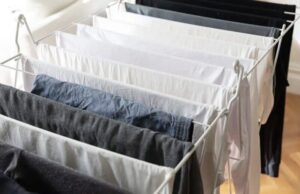
When winter arrives and rain taps on the windows, it may be tempting to hang your laundry indoors. However, this common practice can have harmful consequences for your health and home. Why is it advised to avoid indoor drying? It’s not just about comfort, but a real concern for your well-being and the integrity of your home.

Excessive humidity: a danger for the interior
Imagine a room where the air seems continuously filled with humidity. When you dry your laundry indoors, it releases a large amount of water vapor into the air. This creates an environment ideal for mold growth on walls and ceilings and promotes the proliferation of dust mites.
What are the signs of excessive humidity?
Condensation forming on windows
Appearance of black or greenish stains on walls
Persistent bad odors
Heavy, hard-to-breathe air
Mold is not just an aesthetic problem. It releases spores that can cause respiratory problems, especially for vulnerable individuals (asthmatics, children, elderly people).

Health consequences
Excessive humidity encourages the growth of allergens. This can lead to symptoms such as sneezing, nasal congestion, eye irritation, and constant fatigue. Worse, high humidity levels can worsen conditions like asthma or bronchitis.
What experts say
Studies have shown that indoor humidity levels above 60% create the perfect environment for mold and dust mites. For healthy air, it’s recommended to keep humidity between 40% and 50%.
Solutions for safe laundry drying
Prefer outdoor drying: the best option
As soon as the weather allows, it’s better to dry your laundry outside. This helps control indoor humidity, and the UV rays from the sun have a natural antibacterial effect that helps eliminate bad odors.
And in winter?
Yes, even in winter, as long as the temperature doesn’t drop too low. Laundry dries more slowly, but it’s still a better option than letting it dry indoors for an extended period.
The tumble dryer: a practical solution, but use it in moderation
If you have a tumble dryer, it can be a good alternative. However, frequent use increases energy consumption and may damage delicate fabrics.
Tips to reduce energy impact:
Choose a condensation or heat pump model to save energy.
Spin your laundry well before putting it in the dryer.
Don’t overload the appliance to improve its efficiency.
How to dry laundry indoors safely?
Sometimes, you have no choice but to dry laundry indoors. Here are some tips to reduce the risks:
Regularly ventilate the room by opening windows for 10 to 15 minutes per day.
Keep laundry away from walls to avoid moisture buildup.
Use a dehumidifier to absorb excess moisture from the air.
Use a well-spaced drying rack to speed up evaporation.
Drying laundry in winter: it’s possible!
Although winter complicates laundry drying, it’s not impossible. If you can’t dry outside, here are some tips to shorten the drying time:
Slightly increase the temperature of the room where your laundry is drying.
Create airflow by opening two opposite windows for a few minutes.
Don’t overload the drying rack so air can circulate better between the clothes.
How long does it take to properly dry laundry?
Drying time varies based on ambient humidity and temperature. Indoors, it can take anywhere from 6 to 48 hours. To speed up the process, remember to spin your clothes well before hanging them.
Adopt the right practices!
Drying laundry indoors may seem convenient, but it carries risks for both your health and the condition of your home. Whenever possible, prioritize outdoor drying or the tumble dryer. If you have to dry indoors, make sure to ventilate the room and use a dehumidifier to ensure healthy air.



